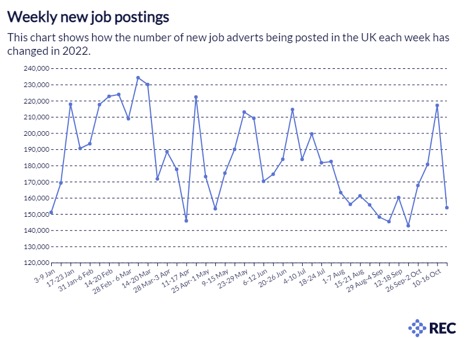- There were 154,000 new job postings in the week of 17-23 October – 3.9% lower than a month earlier
- But there were over 217,000 in the previous week (10-17 October), suggesting demand remains high overall
- The number of active postings has remained relatively stable, with between 1.4 to 1.5 million active job adverts since mid-August
- Notable increases in adverts for jobs in the education and childcare sectors, such as school secretaries and childminders
- Three out of the UK’s top ten hiring hotspots in the week of 17-23 October were in the North West
- Seven out of the UK’s bottom ten hiring hotspots were in Northern Ireland.
The number of active job adverts across the UK has remained relatively stable since mid-August. In the week of 17-23 October, there were 1.4 million active job adverts, according to the Recruitment & Employment Confederation (REC)’s and Lightcast latest Labour Market Tracker.
There has been a fall in the number of new postings in the week of 17-23 October, with 154,000 new job adverts posted – 3.4% lower than a month earlier. The previous week saw strong demand with 217,000 new postings, suggesting that demand, while volatile, remains at a high level overall.
Neil Carberry, Chief Executive of the REC, said:
“After a lull over the summer and during the period of national mourning for Her Majesty the Queen we saw a recovery in hiring in late September. This continued through most of October, with some slowing in the most recent week. Overall, we are still seeing strong demand.
“There are some signs of greater volatility driven by economic and political uncertainty. But these cyclical trends are being offset by a substantial labour shortage that means firms still need to hire, even when growth has slowed.
“On November 17th, the Chancellor has a chance to set out plans for growth which underpin investment by businesses in improving productivity, from skills to employment support to technology. This should include reforming the failed apprenticeship levy to deliver skills where they are needed, better thinking on transport and childcare to support people returning to work, and an immigration system that flexes to meet our economy’s needs.”
Occupations with notable increases in job adverts include childminders (+3.3%), school secretaries (+1.9%), and dental practitioners (+1.3%).
On the other hand, pharmacy assistants (-17%) saw the biggest weekly decline in active job adverts. Bar staff (-16.4%) and waiters and waitresses (-12.8%) also saw a significant decline in active postings.
North West saw growth in job postings in the week of 17-23 October, with three of the only four hiring hotspots with positive growth – Blackpool (+9.3%), Lancaster and Wyre (+2.1%), and East Cumbria (+0.2%).
At the other end of the scale, seven out of the bottom ten local areas for growth in active job postings were in Northern Ireland. Of those, Causeway Coast and Glens (-26.1%), Newry, Mourne and Down (-19.2%), Derry City and Strabane (-19.2%), and Mid and East Antrim (-19%) saw the biggest falls.
John Gray, Vice President, UK Operations at Lightcast, said:
“The number of new job postings in the week beginning 17th October was 70,000 fewer than the previous week, which may well be a reflection of the general volatility and uncertainty we are seeing in Westminster and in the economy. At the same time, when we look at the total number of active job postings, the picture is much more stable, with the numbers having remained at around 1.5 million since the middle of August.
“Putting these two datapoints together suggests that while employers may well be nervous about committing to new hires right now, they still have existing positions which they have not been able to fill, and which they are continuing to advertise for. This, combined with the lowest unemployment rate over the past 20 years suggests that, even in this time of volatility and instability, we are still seeing a very tight labour market.”







